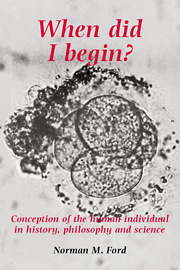Book contents
- Frontmatter
- Contents
- Foreword
- Preface
- 1 Introduction
- 2 Historical influence of Aristotle on the theory of human reproduction
- 3 Criteria for being a human individual
- 4 Fertilization and the beginning of a human individual
- 5 Implantation and the beginning of the human individual
- 6 The human individual begins after implantation
- Appendixes
- Notes
- Glossary
- Index
4 - Fertilization and the beginning of a human individual
Published online by Cambridge University Press: 03 February 2010
- Frontmatter
- Contents
- Foreword
- Preface
- 1 Introduction
- 2 Historical influence of Aristotle on the theory of human reproduction
- 3 Criteria for being a human individual
- 4 Fertilization and the beginning of a human individual
- 5 Implantation and the beginning of the human individual
- 6 The human individual begins after implantation
- Appendixes
- Notes
- Glossary
- Index
Summary
Having established that a human being must be both an ontological individual and a living ontological individual, it now remains to reflect philosophically on the relevant scientific evidence to determine when these two criteria are first satisfied in the species Homo sapiens. It would be wise to begin with a brief review of the pertinent biological facts from fertilization onwards. There is broad agreement amongst embryologists concerning these facts. Disagreements arise among both biologists and philosophers when it comes to interpreting the scientific data in relation to the beginning of a new human individual.
Fertilization
At fertilization there begins a new, genetically unique, living individual, when the sperm and the ovum lose their separate individualities to form a single living cell, a zygote. Fertilization is not a momentary event but a process that may last up to 20–24 hours, beginning with the first contact of the sperm with the plasma membrane of the secondary oocyte (ovum) and finishing with the mixing of the maternal and paternal chromosomes (syngamy) to constitute the zygote. After the process of fertilization is completed the ovum becomes the single–cell pre-implanted zygote prior to its first mitotic division (cleavage) into two smaller identical daughter cells. The term ‘zygote’ is sometimes used to refer to the product of conception for a few days or even a fortnight. In this book I shall use ‘zygote’ to refer only to the diploid cell that results from the completion of fertilization.
Each spermatozoon and ovum is an individual, a living cell, distinct from the mother and father. In due time, these separate individuals fuse to form the fertilized ovum.
- Type
- Chapter
- Information
- When Did I Begin?Conception of the Human Individual in History, Philosophy and Science, pp. 102 - 131Publisher: Cambridge University PressPrint publication year: 1988
- 1
- Cited by



